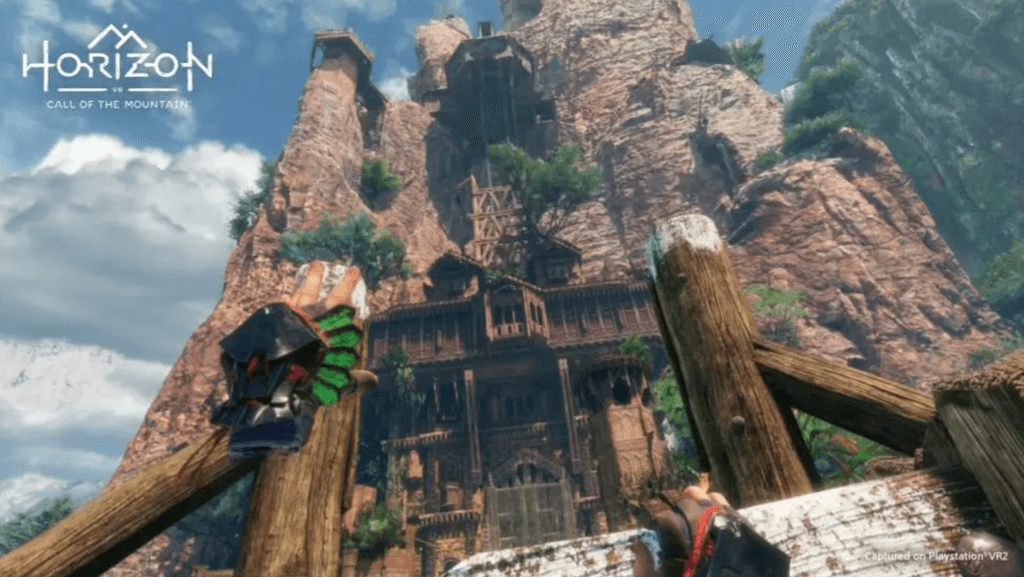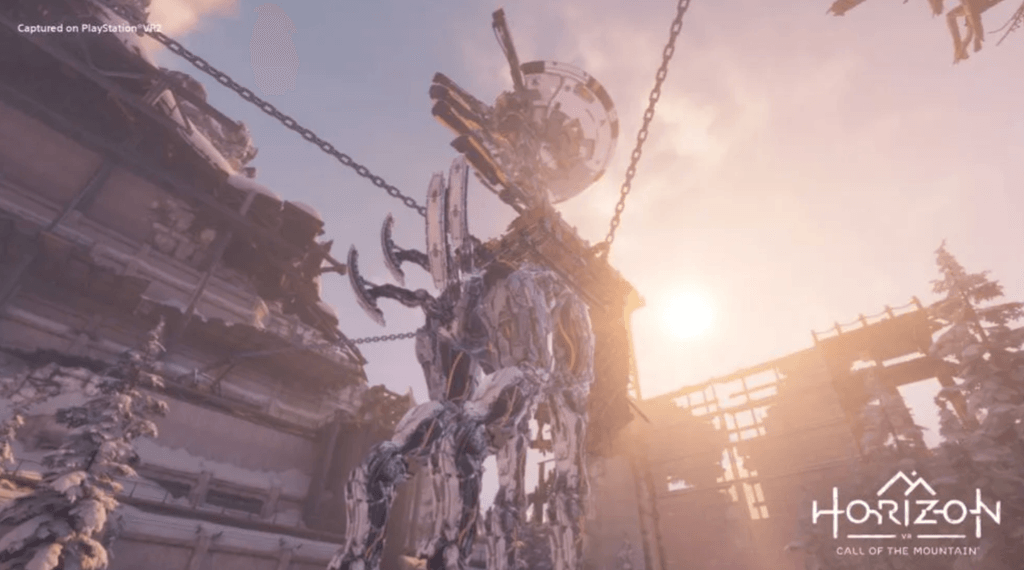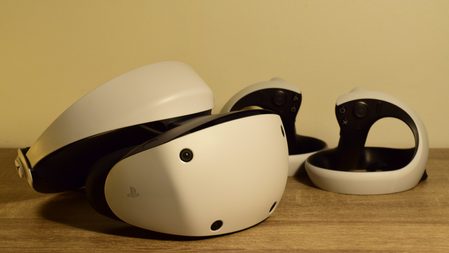SUMMARY
This is AI generated summarization, which may have errors. For context, always refer to the full article.

This article originally appeared on One More Game.
Horizon Call of the Mountain is the latest Horizon installment from Guerrilla Games, albeit not a mainline title like Zero Dawn and Forbidden West, but one for the PS VR2. What could be considered the flagship title for the new hardware, the game sees a new hero not named Aloy take on the many challenges of the wilds in a story about redemption.
As a PS VR2 title, you can expect some fundamental things to change from the base Horizon formula. If you’re looking for some fast-paced mechanical dino hunting, you’ve come to the wrong place (sort of). Instead, you get a fully immersive experience that brings you deep into the heart of the wilderness and will require as much from you as you see on the screen (sort of).
Curious to hear what it’s all about? Read on and find out!
It’s the climb
Horizon Call of the Mountain is basically a standalone platforming title that takes you deep into the Horizon universe, if we could call it that, pitting you against the familiar mechanical threats from the series and teaming you up with equally familiar personalities like Aloy.
You’ll see everything through the PS VR2 headset, setting you up for some stunning views, all while feeling everything through the haptic feedback on both the headset and Sense controllers.
You are the disgraced Shadow Carja member, Ryas, who is on a quest for redemption by uncovering the mysteries of a new threat looming on the horizon (heh). There’s a paper-thin storyline here, and it’s not something that falls under the likes of Zero Dawn and Forbidden West which posed an expansive narrative.
Instead, immersion is the name of the game, and as hinted earlier, you’ll be doing a lot of moving around to get to where you need to be.
By moving around, I mean climbing. If you’ve played any of the Horizon games in the past, you’ll know that the lands are filled with great canyons, mountains, waterfalls, and many natural land formations that can be scaled by Aloy. It’s quite the same here, only this time you’re moving your arms around, looking around for the next peg to grip onto and scaling these mammoth walls.

Of course, you can turn gesture controls off, but where’s the fun in that? Climbing requires you to grip the Sense controller trigger buttons in alternating fashion, all while lifting your arms to grab onto the many ledges and pegs scattered throughout. It’s a great feeling, to be quite honest, and is not as tiring as one may think despite the very light workout.
To provide an immersive experience, the controls in Horizon Call of the Mountain are very intuitive. It takes very little time to get acclimated to the gesture controls, getting you traversing in as little as a few minutes. While combat controls could take a bit of getting used to, exploring is the exact opposite.
You’ll be using a combination of these gestures while looking around to get you where you need to be, and the way the PS VR2 enables this is really special.
One thing that Horizon Call of the Mountain excels at is giving everything a fantastic sense of scale and depth. The mountains look amazingly tall, and tip-toeing on cliff edges really gives you that “whoa” moment when you look at the stunning views across the land.
Forests and rockfaces are not the only things you’ll marvel at, but also the many dino robots scattered throughout. If you’ve ever dabbled in the photo mode of Horizon Forbidden West, taking screenshots of Tallnecks and Stormbirds up close, then you’ll get to do so this time in first-person and in much clearer quality through the PS VR2.
Everything in the game is absolutely beautiful, and it really helps that the PS VR2 can bring the world of Horizon Call of the Mountain to life in vibrant 4K. Having this game be my first “real” entry into VR, there’s certainly that wow factor while playing, and it really brings you closer to all the action.

When you’re not admiring the view or climbing, you’ll be engaged in battle with a number of foes that threaten your journey. Combat in Horizon Call of the Mountain is not as fast-paced and acrobatic as you would expect, and much of the experience will have you do simple dodges while firing a LOT of arrows if you can’t handle aiming.
Gesture controls steal the show once again, as Horizon Call of the Mountain will require you to take an arrow from your imaginary quiver, load it, and pull back to aim and fire. It’s like the real thing, only without the strain and resistance of a real bow, and it is very fun to do so.
Aiming is finicky, but once you get used to it, the full combat experience can be quite exhilarating. Paired with the haptic feedback on both the headset and the Sense controllers, you’ve got a winning formula.
During fights, Ryas will be limited to sidesteps while aiming and firing, and this can be a drastic departure if you’re used to Aloy’s agile movements. This aspect may turn off players looking for something a bit action-packed, but the limited number of times you’ll actually be in a fight in Horizon Call of the Mountain won’t take advantage of it.
Horizon Call of the Mountain also has collectibles and crafting, and while they’re not full-on features of the game, having these on top of a hefty VR experience just adds value to the game. In-between challenges and even just taking in the sights and sounds via the Machine Safari, the PS VR2 sets everything up beautifully.
Mountain sickness
As a VR newcomer myself, Horizon Call of the Mountain was a great experience overall. I thought I wouldn’t be able to handle the scenery, considering I have a slight fear of heights, but it wasn’t so bad when I was strapped in.
Admittedly, I felt nauseous during some climbing sections, especially during moments when the view is directly obstructed by walls and mountain faces. I noticed an uneasy feeling in my tummy every time things got too close for comfort, but mileage may vary, and it definitely helped me more playing in short 30-minute to 1-hour bursts rather than a full-on 3-hour session.
As much as I nagged about how combat wasn’t as fast-paced as the mainline Horizon games, it may have served me well because, unlike climbing, I never felt queasy during battles with these mechanical beasts.
Without a full arsenal and skill tree upgrades, enemies are understandably spongy, more so if you fail to hit their weak points. Combat in Horizon Call of the Mountain is something that didn’t really impress, but it was serviceable, to say the least.

Helping out is a massive suite of accessibility options that will try to make your Horizon Call of the Mountain a pleasant one. There’s an option for almost everything, from controls to gestures and even eye tracking, you’ll need to dig deep to find a profile that suits you the best.
For a VR newbie like me, this was something that was intimidating to do due to the lack of knowledge of which settings worked best, but I was very appreciative of the number of sliders to tinker with and the idea that I could improve my experience by turning some things on or off.
What we liked:
- Impressive use of PS VR2
- Visual fidelity is sublime
- Solid platforming mechanics
What we didn’t like:
- Combat is not a big part of the game
- There are a LOT of climbing sequences
- Aiming with the bow can take a bit of getting used to
Verdict: Wait for it…
Horizon Call of the Mountain sets out to do something and does it well. It’s a game that showcases the capabilities of the PS VR2 to great effect, possibly giving players a reason to take a chance at the new hardware.
The scenery in the game is absolutely breathtaking, and when paired with the OLED display of the VR2, is really something that needs to be seen to be fully appreciated. That said, Horizon Call of the Mountain has climbing/platforming sequences that make up a huge chunk of the game, leaving little for others like actual combat and exploration, which makes the overall package a bit monotonous and repetitive.
To call it a climbing simulator could be a fair assessment, but it’s hard to deny the game of what it really is, which is a spectacular showcase of the new hardware from Sony. Is it the killer app for the PS VR2? Arguably, I’d say it isn’t, but I cannot deny how Horizon Call of the Mountain has made me look forward to what’s next on the VR front.
Horizon Call of the Mountain was reviewed on a PS VR2 with a review code provided by the publisher.
Add a comment
How does this make you feel?






There are no comments yet. Add your comment to start the conversation.